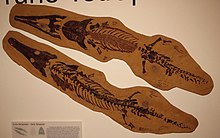Archegosauridae
| Archegosauridae Temporal range: Early Permian-Late Permian | |
|---|---|

| |
| Archegosaurus decheni fossil at the paleontological collection of the Museum of the University of Tübingen | |
| Scientific classification | |
| Domain: | Eukaryota |
| Kingdom: | Animalia |
| Phylum: | Chordata |
| Order: | †Temnospondyli |
| Superfamily: | †Archegosauroidea |
| Family: | †Archegosauridae Lydekker, 1885 |
| Genera | |
Archegosauridae is a family of relatively large and long snouted temnospondyls that lived in the Permian period. They were fully aquatic animals, and were metabolically and physiologically more similar to fish than modern amphibians.[1] The family has been divided into two subfamilies, the longer-snouted Platyoposaurinae and the shorter-snouted Melosaurinae.
Gallery
Platyoposaurinae
- Prionosuchus plummeri, of the early Permian of Brazil
- Platyoposaurus watsoni, of the early to middle Permian of Russia
- Platyoposaurus stuckenbergi, of the middle Permian of Russia
- Collidosuchus tchudinovi, of the middle Permian of Russia
Melosaurinae
- Melosaurus platyrhinus, of the early to middle Permian of Russia
- Konzhukovia vetusta, of the middle to late Permian of Russia
- Tryphosuchus, of the middle to late Permian of Russia
References
- ^ Florian Witzmann; Elizabeth Brainerd (2017). "Modeling the physiology of the aquatic temnospondyl Archegosaurus decheni from the early Permian of Germany". Fossil Record. 20 (2): 105–127. doi:10.5194/fr-20-105-2017.
- Ruta, M., Pisani, D., Lloyd, G. T. and Benton, M. J. 2007. A supertree of Temnospondyli: cladogenetic patterns in the most species-rich group of early tetrapods. Proceedings of the Royal Society B-Biological Sciences 274: 3087–3095.












